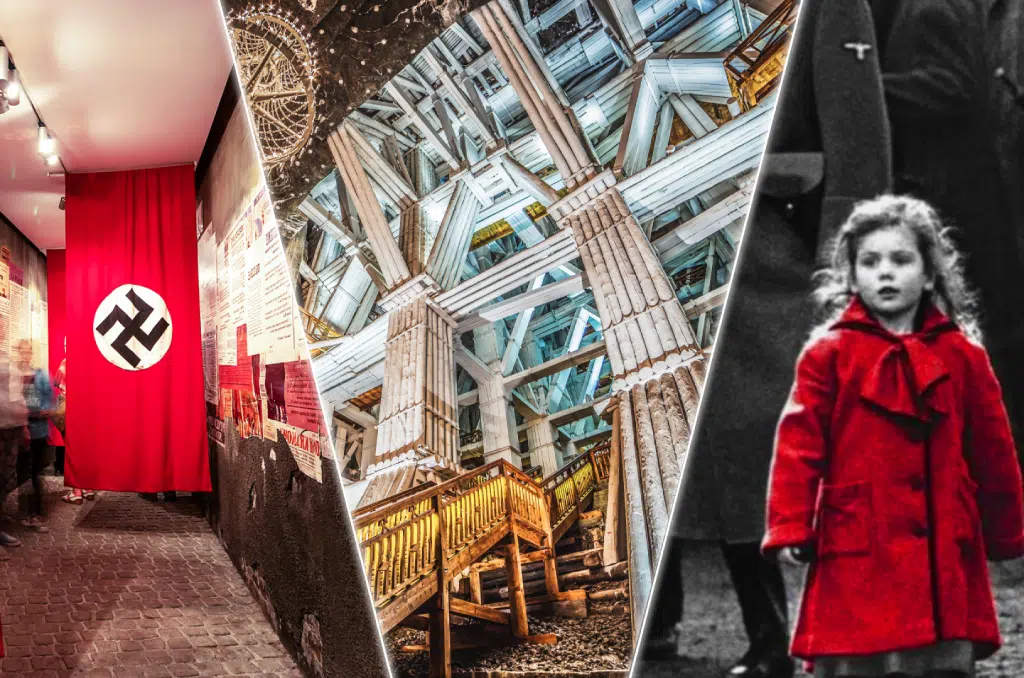A black period in the history of mankind – holocaust
World War II is the largest and most tragic conflict the world has ever seen. We associate the 1940s mainly with Nazism and the Holocaust. The crimes committed against the Jewish population make us shudder to this day. Concentration camps built on Hitler’s orders are infamous remnants of that period. The largest, and at the same time the most recognizable centers were built on the territory of occupied Poland.
Today the concentration and extermination camps function as memorials. The Auschwitz-Birkenau state museum (located in Oświęcim) is visited by millions of tourists from all over the world. At the exhibition in blocks, there are authentic personal belongings of prisoners. Toys, jewelry, clothes or signed suitcases are some of the most shocking items. It is worth mentioning that, the former camp is listed as a Unesco World Heritage Site. You can read more about auschwitz facts.
Interestingly, the first exhibition at Auschwitz was opened as early as 1945. Part of the main camp was then developed for visitors. The program was constantly expanded with new blocks. After 8 years, an exhibition was created, much of which has survived to this day.
Hunger and unimaginable physical exertion – life in Auschwitz
Among those sent to the camp were Jews, homosexuals and Polish political prisoners. The conditions in which people lived in Auschwitz were tragic. They slept in barracks that constantly hosted lice and rats. Their meals consisted of only a slice of bread with side dishes, sometimes soup or a piece of sausage. The products used to prepare meals were stale and mouldy.
Prisoners performed heavy physical labour, which lasted up to a dozen hours a day. The commanders paid no attention to the harsh weather conditions or the health of the workers.
Many people didn’t make it through the entire workday.
Cruel medical experiments were carried out on prisoners, especially women and children. Among other things, the tests involved anatomical changes.
The greatest tragedy of the German nazi concentration and extermination camp was that people lost their humanity there. For the prisoners, survival became the overriding goal. This often involved immoral decisions and actions.
Escape attempts
Escape from Auschwitz was virtually impossible. The entire camp was fenced off with barbed wire, and SS men constantly guarded the passages and made regular checks. In addition, the physical condition of the prisoners did not allow them to at least take a long run.
However, the history of the camp includes escape attempts. In 1942, 4 men disguised themselves in SS uniforms and managed to break free. It is worth mentioning that not all similar actions were successful. Any sign of insubordination was severely punished. After escape attempts, SS men took revenge on the remaining prisoners in the camp, often sending them to the gas chamber.
January 27, 1945 – liberation day
The initial evacuation of prisoners took place as early as 1944. The German nazis tried to erase the traces of their crimes at all costs. At that time, records and vital camp documents were destroyed. They also managed to blow up the crematoria and gas chambers in several parts of the camp.
Eventually, the Red Army began to advance further and further west. The closer they got to Krakow, the more nervous the camp commanders became. In mid-January, the nazis ordered the forced evacuation of prisoners from both Auschwitz and Birkenau. Some were supposed to evacuate on foot, while others moved in freight cars. Thousands of people died during this operation.
On January 27, 1945, Soviet soldiers liberated Auschwitz. They were greeted by the prisoners as heroes and saviours. About 7,000 people could breathe a sigh of relief.
To await liberation… history through the eyes of prisoners
The day of liberation turned out to be exceptionally cold. The barracks were covered with a thick layer of snow. Moreover, A deafening silence reigned in Auschwitz-Birkenau. The prisoners were starved, searching strenuously for food in the ruins of buildings destroyed by the Germans. They found the sight of the Soviets shocking. Some were afraid to come out of hiding, while others welcomed the soldiers with joy. At the time, no one thought they would live to see the day of liberation.
Each survivor presents the story of Liberation Day differently. One woman recounted years later that the Soviets turned out to be completely indifferent to their fate and did not give them the help they needed. She also revealed that the Russians made a field kitchen and threw them a piece of horse carcass. On the other hand, some Poles liberated in late January remembered the soldiers very positively. They claim that the Soviets gave the prisoners canned food and even a few cubes of sugar.
Of course, liberation did not look like the former soviet union propaganda portrayed it. However, there is no doubt that the Soviets saved from death thousands of Auschwitz prisoners.
Auschwitz-Birkenau concentration camp years later
The lives of Holocaust survivors never returned to normal. Former prisoners often involuntarily returned to the memory of the terrible events that took place in the camp. They were often haunted by nightmares, some also suffered from insomnia. It is worth mentioning that survivors stubbornly hid food for fear of starvation.
The extant parts of Auschwitz reflect as closely as possible the living conditions that prevailed there in the 1940s.
Some of the former Auschwitz prisoners decided to visit the museum after many years. The sight of the blocks and barracks proved overwhelming to many of them. Many survivors decided to write down their memories. The story of Halina Birenbaum or Tadeusz Borowski is known all over the world. Also noteworthy are the memoirs of victims of the holocaust in other European countries. Based on the story of Anne Frank, many films and animations have been made.
Explore the auschwitz and organize your guided tour
The largest of the german nazi camp is located near Kraków, in the town of Oświęcim. Auschwitz museum undergone a series of restoration and renovation works. Everything is described in detail in the documents of the site.
Today the area of the former concentration camp is made available for tourists to visit. Krakowdirect offers convenient access to the very gate of the holocaust museum. You can take advantage of both individual and group offers for Auschwitz tours. We provide modern minivans that will meet the expectations of even the most demanding passengers. It is worth adding that the drivers who work with us are always smiling and happy to answer all your questions.
Explore the history of Auschwitz and organize your visit to the museum and memorial today.
















